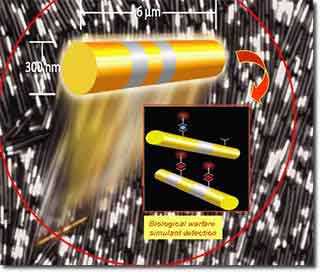| Posted: August 8, 2006 |
Nanowire barcode system speeds biodetection in the field |
|
(Nanowerk News) Detecting biowarfare agents in the field will become a lot easier thanks to a new barcode system based on biosensing nanowires developed by Lawrence Livermore National Laboratory (LLNL) researchers.
|
|
The researchers, led by Jeffrey Tok of LLNL’s BioSecurity and Nanosciences Laboratory, built submicrometer layers of different metals including gold, silver and nickel that act as “barcodes” for detecting a variety of pathogens ranging from anthrax, smallpox and ricin to botulinum.
|
 |
Multi-striped nanowires developed at LLNL allow rapid and sensitive immunoassays for biowarfare agent simulants. (Source: LLNL)
|
|
The team, led by LLNL and including researchers from Stanford University, the UC-Davis Center for Biophotonics and Nanoplex Technologies, used the multi-striped metallic nanowires in a suspended format to rapidly identify sensitive single and multiplex immunoassays that simulated biowarfare agents.
|
|
The researchers produced nanoscale wires by electrochemically depositing metals within the tiny cavities of porous mineral solids. They then layered the gold and silver in a specific way to produce nanowires with different characteristic stripe patterns depending on which pathogen they were trying to identify.
|
|
The reflection pattern and fluorescence from each stripe sequence can later be clearly recognized, similar to a barcode on a retail product.
|
|
“Antibodies of specific pathogens have been attached to the wires,” said Jeffrey Tok, principal author from LLNL. “This produces a small, reliable, sensitive detection system that can easily be taken into the field.”
|
|
The system not only applies to biowarfare agents, but could also be used during an outbreak of an infectious disease.
|
|
The research appears online in the journal Angewandte Chemie.
|

